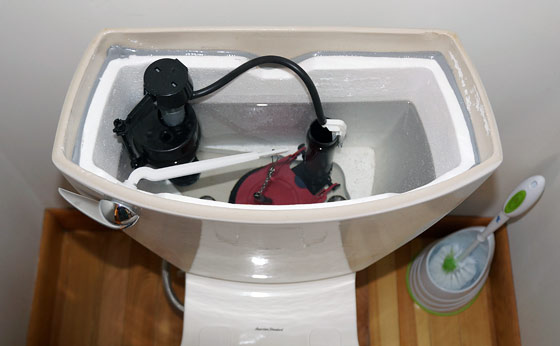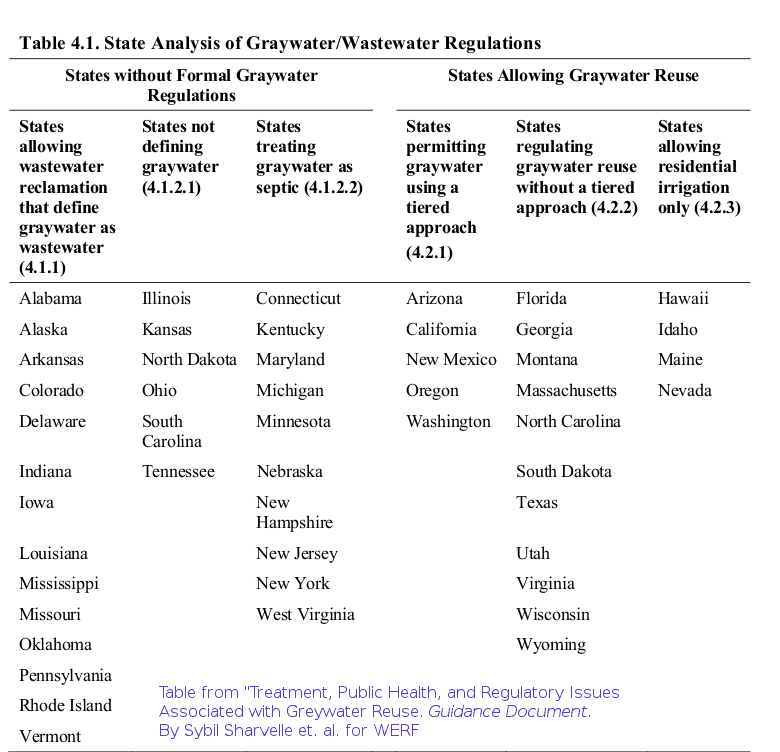Greywater systems are growing in popularity, and if you’re reading this, chances are you know a thing or two about them. But what methods of greywater disposal are there? And how can you integrate them into your home?
In this article, we outline three different ways to dispose of your greywater from your storage tank. We also highlight guidelines that are important to greywater storage.
Table of Contents
Is Greywater Safe To Dispose Of?
While greywater contains some household detergents and skincare products it is still safe to dispose of it in your garden. There are a couple of different ways in which you can dispose of greywater safely, including irrigation or toilet flushing.
A Quick Note
Before we go any further, it’s essential to take note of the different greywater laws and regulations.
Each country has its codes and regulations for the disposal of greywater. In the United States, each state has different laws. Therefore, it’s important that you research and understand the codes in your area before deciding how to dispose of greywater.
What is n Greywater?
Greywater consists mainly of detergents and skincare products.
When looking at greywaters elements, we see organic material and chemical compounds. In fact, according to this study, almost half of the compounds in greywater are capable of decomposition.
There are two different kinds of chemicals found in greywater – ones that harm the environment and ones that can act as fertilizer.
Chemicals that act as fertilizer include Phosphorus, Nitrogen, and Potassium. These are found in cleaning detergents and other household waste such as coffee grounds.
The flip side of the coin is chemicals that harm the environment, such as parabens, microplastics, sulfates, and oxybenzone.
The Bottom Line
Whether or not greywater is safe to dispose of depends on the household cleaning products you use.
But don’t worry, unless your household uses an abnormal amount of detergent, your greywater is safe to use.
To find out more about greywater, click here.
3 Ways To Dispose Of Greywater Safely
Here are three ways in which you can dispose of greywater safely in your home:
Toilet Flushing
Using greywater to flush your toilets is the simplest method of greywater disposal.
It’s as simple as catching the greywater from your sinks and dishwasher in a storage tank, then using a bucket to collect the water and filling the cistern of your toilet.
It is however possible for you to opt for a more complex system that requires less manual labor.
This type of system requires a little more plumbing. First, you’d collect the greywater in a storage tank and then pump it through pipes and into your toilet cisterns.

Source: modernsurvivalblog
Irrigation
Using greywater to water your garden is the most common way of greywater disposal.
You can link the storage tank to a simple irrigation system that waters your plants. That said, we advise that you don’t use sprinkler or aeration systems. Instead, make use of drip systems that water your plants’ roots directly.
You can use greywater to water all types of plants, including your herb and vegetable garden. However, there are guidelines when it comes to these types of gardens.
For example, you need to ensure that the greywater doesn’t come in direct contact with the edible part of the plant. This is to prevent any transfer of pathogens from the greywater to you.

Source: atsirrigation
Ground Integration
If you’re collecting greywater, you already know the advantages it comes with. But what do you do when your demand for greywater is lower than your supply?
What do you do when your tank is constantly full, and you don’t want to overwater your plants?
The best option is to discharge the greywater into the soil without letting it pool up. The best way to do this is through a french drain.
People typically use French drains to remove water build-up against basement walls. But, you can also use them to safely integrate water into the ground.
The drain consists of a perforated tube placed in a layer of gravel in the ground. The water flows into the tube and drains out along its length. The water then soaks through the gravel and into the soil surrounding the drain.
This is one of the safest ways of greywater disposal.

Source: engineeringclicks
Greywater Storage Guidelines
But how should you store greywater before you dispose of it?
Most greywater systems include a storage tank, regardless of whether you build it yourself or purchase a system. However, you should follow a couple of guidelines when storing your greywater.
Codes and Regulations
As previously mentioned, different codes and regulations determine how to dispose of your greywater. Your national or local governments determine these regulations.
For example, regulations in the U.S. are determined by the state’s local ordinances. Below is a table that outlines which states allow greywater use and disposal.

Source: greywateraction.org
Conversely, in the UK, you’ll find these regulations in national building regulations and other documents. To find out more, you can refer to Approved Document H: Drainage and waste disposal and WRAS Information and guidance note 09 02 04: Reclaimed Water systems.
Our Guidelines
In this article, we’ll highlight a couple of guidelines for storing greywater. It’s important to remember that these guidelines are general guidelines. They won’t apply to everyone, and you should research what policies are in your local area.
Storage Tanks

Source: homeinsulations
- Don’t store greywater longer than 24hrs. We advise that you use the greywater as soon as possible.
Keeping your greywater in storage for longer than 24hrs can cause bacteria to grow in the water. The bacteria growth will then create an unpleasant odour as the organic matter breaks down. - Seal your storage tank in such a way that you can clean it. Having a closed storage tank prevents any accidental handling of the greywater or overflow.
In addition, sediment will collect at the bottom of the tank. You’ll need to remove this sluge over the years otherwise your system will clog up.
- Your greywater system should have a 3-way valve for rainy seasons. If you’re using your greywater for irrigation, you won’t need as much greywater in the rainy seasons.
To prevent your system from overflowing, install a 3-way valve. This will away the water to flush down the sewer instead of flow into your storage tank.
Handling Greywater
- Your should refrain from directly handling the greywater. We advise that you use gloves to prevent the spread of pathogens present in your water.
- If you use your greywater for watering your plants, make sure to irrigate the soil directly. It’s best to prevent the water from coming in contact with the parts of the plants that are above ground.
- Don’t use greywater directly on vegetables or gardens with acidic soil.The greywater can contaminate the vegetables with bacteria or pathogens. Additionally, greywater tends to have a basic pH level. This means that it will change the pH level of your acidic soil.
Greywater Run-off

Source: 123rf
- It’s important to not let greywater run-off in your garden. If the greywater pools up in low spots, puddles can form. These puddles can become breeding spots for mosquitoes and encourage algae and bacteria growth.
- Do not discharge greywater into ponds. This can damage the existing ecosystem of the pond, affecting plant and animal life.
Final Thoughts
Greywater systems are great! They save you money and help you to reduce the amount of water that you use, helping the environment. However, dealing with greywater can be tricky.
There are a lot of codes and regulations around storing greywater, which vary depending on your country or state. Therefore, it’s essential to use greywater as soon as you can.
Irrigating crops, flushing toilets, and ground integration are some of the best ways to use your greywater quickly.
You can integrate greywater disposal into your existing systems with ease, releasing your greywater safely into the environment.

